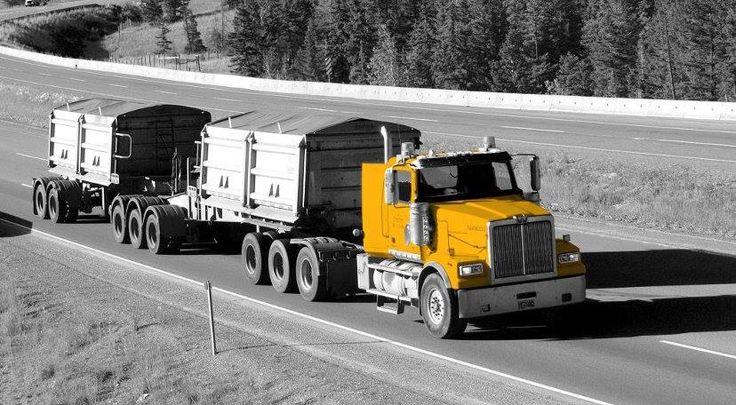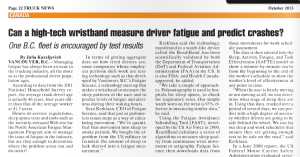Safety expert Siphiwe Baleka says monitoring fatigue can help end trucking’s health crisis
As a world-class swimmer, US-record holder Siphiwe Baleka knows how important sleep is to human performance. As a transportation expert, however, this Yale University graduate also knows that sleep is often an afterthought for drivers rushing to meet the demanding deadlines of the trucking industry. While the consequences associated with those demands are proving to be far more costly and tragic than winning or losing a swim race, Baleka thinks the road to more successful outcomes is similar.
“Every driver, if they are being honest, is going to tell you that on a daily or nightly basis, they are going to fight fatigue,” says Baleka, “When you are serious about it and you legitimately want to make safer highways, genuinely and credibly, you have to talk about sleep first.”
The National Highway Traffic Safety Administration conservatively estimates that 100,000 police-reported crashes are the direct result of driver fatigue each year in the United States. This results in approximately 1,550 deaths, 71,000 injuries, and $12.5 billion in monetary losses.

Staying awake for 21 hours causes fatigue equal to a Blood Alcohol Content (BAC) of 0.08.
Drivers’ life expectancy is a shocking 15 years lower than the national average, according to Baleka. As such, he’s spent the better part of the last four years looking for ways to usher in change to the trucking industry, specifically the health and safety of drivers. At the root of that poor health, says Baleka, is fatigue.
“For me if I want to solve a problem I want to get to the root of the problem,” says Baleka, now the owner of Fitness Trucking and Driver Health and Fitness Coach at Prime Inc., a Missouri trucking company with 6,700 drivers. “So what’s happening to drivers is, they’re living in a box, they’re sedentary, their sleep is interrupted, which is impacting their circadian rhythms, which is impacting hormone production. So what they experience is an energy deficit, or fatigue.”
Fatigue causes more accidents than drugs and alcohol combined. Research reveals that going 21 hours without sleep is equivalent to a Blood Alcohol Content (BAC) level of .08, above the legal limit for safe driving. Yet measuring fatigue is not even on the radar for many driver health and safety programs, something that needs to change, according to Baleka.

Siphiwe Baleka is a US-Masters Swimming Champion and a US-record holder in the 50M freestyle.
As Baleka started to experience a surprising decline in his own physical health, a light bulb went on: What if he applied the techniques he’d used as a high performance swimmer to truck driving? Companies measure and monitor tire pressure, fuel consumption etc., and often keep rankings, displaying which drivers are doing the best job of what. Baleka says his competitive spirit always drove him to try to be at the top of the chart no matter what was being measured both in the pool and at work. Eventually he determined that a crossover with his background in high-performance sport offered very real opportunities for solving driver health and safety issues. Most importantly, it could help ensure long-haul truck drivers get where they needed to go, safely.
“I started to treat driving as an athletic performance, trying to figure out how I become a better driver,” says Baleka. “How can I be more elite? Just like I wanted to be the best swimmer or best athlete, I wanted to figure out how I could be the best driver. And I started trying all of these things to try and improve my health in this unique environment of long haul truck driving.”

Siphiwe Baleka featured in Sports Illustrated.
While diving in deeper and deeper into his search for solutions to the health issues facing the trucking industry, Baleka tested every fitness program and product he could get his hands on, including a flood of new wearable tracking devices. From that deep dive he developed what would eventually become an award-winning health program designed specifically for truckers. A big part of the solution, he discovered, lays with effectively monitoring fatigue.
“We have real time data on the truck, what it’s doing, it’s brakes, fuel economy etc. We have real-time data on the trailer. The only thing we didn’t have real-time data on is on the driver, which is the most important part of the equation! So I was trying to find a way to combine all of these devices and measure fatigue. That was my Holy Grail because that’s the major factor in so many accidents. You want safer highways you want to do something about driver fatigue.”
While he tested the value of every type of technology he could find, Baleka found that many of the devices were hard to use, didn’t stand up under pressure, or didn’t offer credible data and practical solutions to real issues. This was particularly true when looking for accurate measurement of sleep and fatigue. That is, until he found his Holy Grail.
“I was thinking how amazing it would be if you could have something that could tell you your status for driving based on fatigue, not only so the driver could intervene on themselves but also in a way that could impact the entire industry.”
“For me, as a driver but also as an athlete that wants to perform, the Fatigue Science Readiband can be used in both. There are lots of devices out there that do sleep metrics, but the Readiband is more expansive, more in depth.”
By becoming aware of detailed elements of his sleep, including wake episodes, sleep latency, sleep efficiency and a real time mental effectiveness score, Baleka was motivated to perform better. In short order he went from averaging about 6 hours and 15 mins of sleep a night to about 7 hours and 20 mins of sleep a night.
“I was getting this extra hour and I was feeling better. As an athlete I am swimming faster and performing better. But as a driver, I am feeling less fatigued, I am getting through the shift not having to fight sleep as much.”

Fatigue Science allows fleet managers to see fatigue dangers across the entire workforce. Learn more about monitoring fatigue and reducing safety risks.
Baleka says that by monitoring fatigue, everybody in the industry, from carriers, to shippers and receivers, to drivers, stands to benefit. With healthy drivers, there are less accidents, with less accidents more freight is delivered, safety records go up and insurance costs down.
“We have this technology that can actually predict when you are going to be at high risk for an accident and as a driver you can intervene. But I see that there are ways that the whole industry can use a device like this as a game-changer and we can revolutionize the entire industry.”
“I don’t know who said it first, but if you can measure it, you can improve it,” says Baleka. “So let’s start measuring fatigue in real time so we can improve it.”
Learn more about measuring fatigue and improving driver health and safety.
Interested in learning more about data-driven fatigue management?
or download our free eBook on the Science of Sleep for industrial workforces


